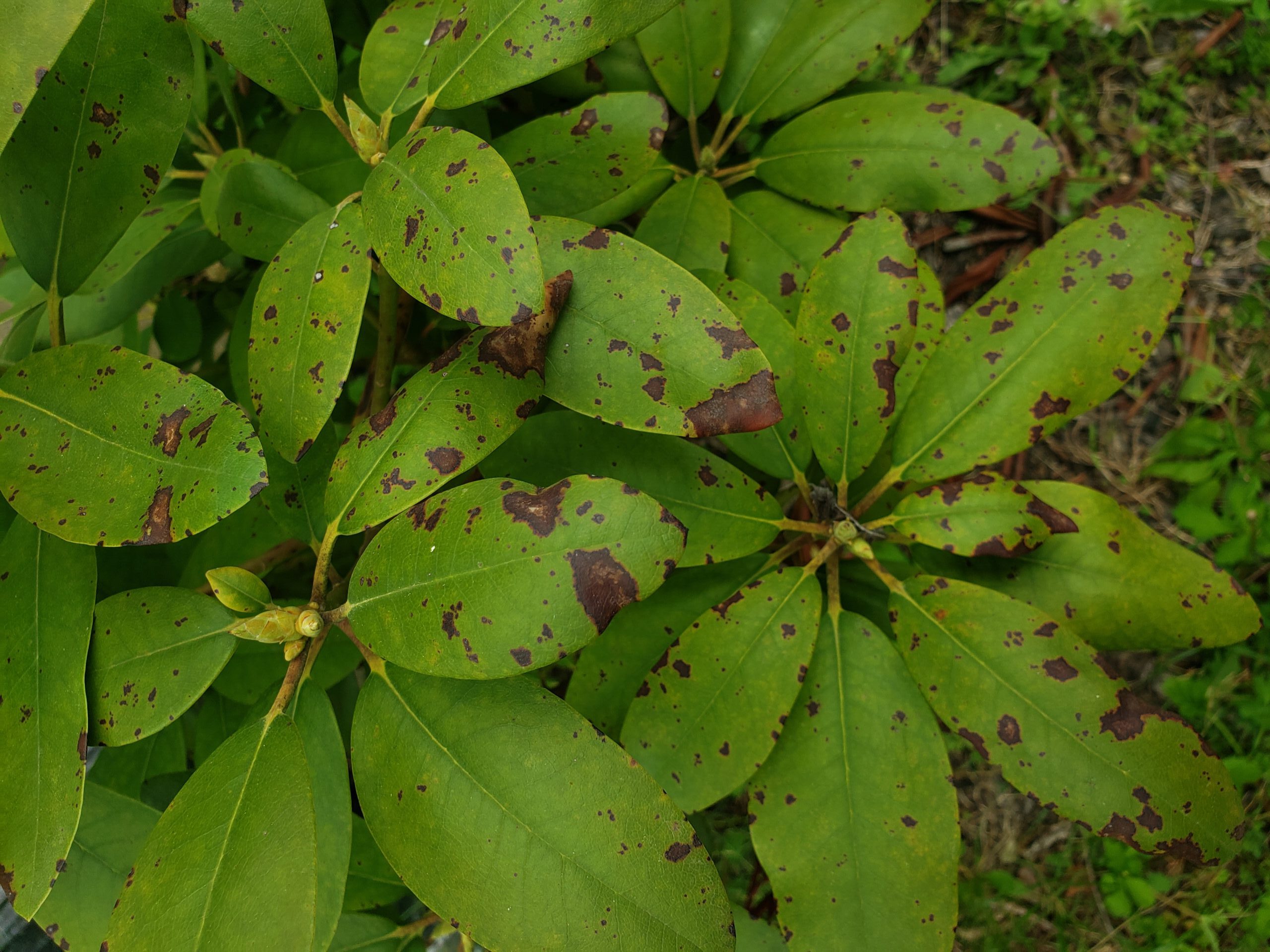Issues with rhododendrons are rare as they are relatively low maintenance plants. Rhododendron pests and disease harm plants that are stressed due to environmental conditions or injury. Common problems of rhododendron bushes can be avoided by providing the best growing environment possible and maintaining a consistent pruning, mulching and fertilizing program.
There are several diseases that could cause black spots on your rhododendron, but one of the most common is Cercospora leaf spot. A fungal disease that causes irregular brown spots on the leaves, usually attacking lower leaves first. The spots turn lighter tan in the center and you may see small dark pimples about the size of a pinprick inside the larger spots on close inspection. These are the fruiting bodies of the fungus that will produce spores that spread the infection to healthy leaves. Rake and destroy fallen leaves to remove as much of the source of infection as possible.
Apply a fungicide in early spring as new growth appears to protect new growth from infection. Begin fungicide application when new growth starts and make repeat applications as directed on the label. We suggest using Bonide’s Fung-onil multi-purpose fungicide spray or Bayer’s 3-in-1 Insect, Disease and Mite Control spray.
If any of the stems are wilting in connection to the leaf spotting and yellowing, there are two other diseases that may be responsible: Botryosphaeria canker or phytophthora root rot. Botryosphaeria canker is a fungal disease characterized by sunken, dark brown cankers on the stems. The leaves on affected stems wilt as this causal fungus destroys the vascular tissue in the stem. You can see tiny black spots, which are the fruiting bodies of the fungus, in the dead bark over the cankers.
Drought stress predisposes susceptible rhododendrons to this destructive disease. Although you have been watering this year, dry weather in previous years may cause an accumulated stress that made them more susceptible. Continue to water as long as the weather is dry, but stop when we are getting sufficient rain.
Prune out and destroy dead stems, and make sure you cut back to sets of leaves where there are buds that will begin to grow. Do not leave large dead stubs that invite infection by this disease. There is no chemical control for botryosphaeria canker.
Phytophthora root rot causes rhododendrons to wilt, and affected plants may be stunted. The wilted leaves may be marked with dark brown spots and usually turn a dull yellow-green color before becoming entirely brown. The shoots appear to die from the tip back as the fine feeder roots are killed and can no longer take up water. Phytophthora is more likely to occur in rhododendrons planted in heavy soil that drains poorly.
You can check to see if phytophthora is to blame by examining an affected stem at ground level. Peel back some of the bark and look at the underlying tissue. You will see a distinct boundary between healthy white tissue and diseased brown tissue. While fungicide applications can protect uninfected plants, plants that are already infected inevitably die. If phytophthora is confirmed, infected rhododendrons should be removed.
Too much water and overhead watering can lead to plant distress –
Rhododendrons are shallow-rooted plants and appreciate extra water when we are not receiving sufficient rainfall. However, drip irrigation and soaker hoses that keep water on the ground and off the plant are best ways to water. If that is not likely, at least use a watering wand and direct the water to the soil as much as possible. Although plants get wet when it rains or when there is heavy dew, there is no need to make the problem worse by overhead watering.
It is best to water first thing in the morning so that plants dry as quickly as possible when the sun comes up; overhead watering in the evening guarantees that leaves will stay wet all night, increasing the chance of disease development. Too much water however can also be bad as it can cause root rot. Wilting leaves can be an indication of both too little and too much water.
Yellow leaves on your Rhododendrons? – Chlorosis – Chlorosis, an iron deficiency, is common in rhododendrons and causes leaves to turn from a rich dark green to a light green or even yellow. New leaves may even emerge completely yellow. Chlorosis becomes a problem when the soil pH is 7.0 or higher. Amending the soil with sulfur and providing an iron fertilizer will help correct the problem
Read more at Gardening Know How: Issues With Rhododendrons: Dealing With Rhododendron Insect Problems And Diseases –
https://www.gardeningknowhow.com/ornamental/shrubs/rhododendron/issues-with-rhododendrons.htm
Contributing authors – Sandy Feather, Susan Patterson


